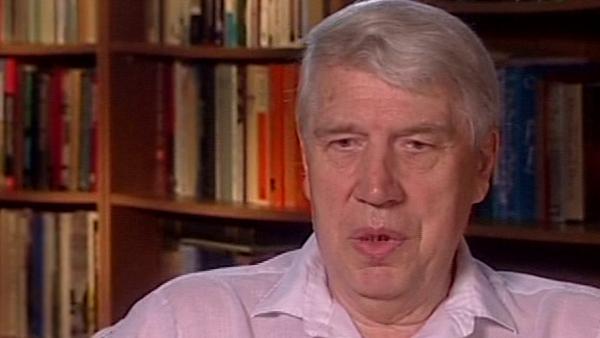NEXT STORY

Competing with Shreffler's lab
RELATED STORIES

NEXT STORY

Competing with Shreffler's lab
RELATED STORIES


|
Views | Duration | |
|---|---|---|---|
| 51. Difficulty of explaining the H2 system | 33 | 05:47 | |
| 52. Working on H2 with Hugh McDevitt | 86 | 04:50 | |
| 53. The two-locus model of H2 | 37 | 07:06 | |
| 54. Publishing a controversial essay | 60 | 03:53 | |
| 55. Presenting the H2 locus model in Asilomar | 32 | 02:17 | |
| 56. Editor-in-chief of the new Immunogenetics journal | 36 | 03:44 | |
| 57. The role of lymphocytes in H2 | 26 | 04:30 | |
| 58. Using cytotoxicity and immunofluorescence | 37 | 04:09 | |
| 59. Why it took us so long to find these antibodies | 28 | 05:36 | |
| 60. Competing with Shreffler's lab | 25 | 02:55 |


So, we tried both tests but then in the end focused primarily on the immunofluorescence because my wife, Dagmar, had a lot of experience with this test and so she participated and Vera Hauptfeld who joined me from Croatia, born originally in Czechoslovakia, joined me in the laboratory and we together tried to find whether we can detect any antibodies there in the serum that we were producing. We were focusing primarily on the combination of the recombinants that I produced during my earlier studies because they gave, in combination with Jack Stimpfling's recombinant, what we needed... the identity of the K and D loci. Well, eventually... for a long time we couldn't find anything and in the retrospective it seems like... to an outsider it might seem like, how come? I mean, why? Later everybody was able to find out these antibodies... find these antibodies and why did it take so long for you to find them and other people as well? Well the problem was again really technical. In both assays we could see killing of cells but it was never 100%. We never... in all the other assays, especially in agglutination, all the cells become clumped together if you have a good antibody and with the cytotoxicity test with other antibodies, that was the same way. If you had a good antibody you got 100% killing, so that's what we were looking for.
It took a while for us to realize that perhaps there is in the lymphocytes only a small population of cells that bear this antigen and so we should not expect that all the cells will be killed and only some cells will be killed or stained in the immunofluorescence. But then still the problem was that if you used them for cytotoxicity or immunofluorescence you often had the so-called background. You often... you always have a background. Some cells are killed non-specifically, no matter... they are not killed by the antibodies that you are looking at... for, but by some other factors present in the serum, so you always have some cells killed or some cells stained, and the problem was to differentiate what was really the positive and differentiate it from the background. In the case of the complement components, not all the complements were of the same quality. Complement you got as a source of complement usually was used the rabbit, a normal rabbit serum, but you had to test... eventually we realized that you had to test 50 rabbits, sera from 50 rabbits, to find one which was suitable for this, because many of them killed unacceptably high number of the cells.
In the immunofluorescence the test was similar problem but of a different nature. The cells often stained other cells because again you were using a third component which was reacting with these cells non-specifically. So, the problem was to differentiate the background from specific reactivity. Well, eventually... it took us a while to convince ourselves that we have such a difference and that it was reproducible and that you can really distinguish certain... if you had, especially if you a low non-specific background... some specific staining or killing. So, there were antibodies present and further testing revealed that they are indeed specific for antigen that is controlled by the middle portion of the H2 complex and that it was mapping with the help of other recombinants, it could be mapped to what then became to be called the IR region, or IR region of the H2 complex.
Born in 1936, Jan Klein is a Czech-American immunologist who co-founded the modern science of immunogenetics – key to understanding illness and disease. He is the author or co-author of over 560 scientific publications and of seven books including 'Where Do We Come From?' which examines the molecular evolution of humans. He graduated from the Charles University at Prague in 1955, and received his MS in Botany from the same school in 1958. From 1977 to his retirement in 2004, he was the Director of the Max Planck Institute for Biology at Tübingen, Germany.
Title: Why it took us so long to find these antibodies
Listeners: Colm O'hUigin
Colm O'hUigin is a senior staff scientist at the US National Cancer Institute. He received his BA, MSc and PhD at the Genetics Department of Trinity College, Dublin where he later returned as a lecturer. He has held appointments at the Center for Population and Demographic Genetics, UT Houston, and at the University of Cambridge. As an EMBO fellow, he moved in 1990 to the Max Planck Institute for Biology in Tübingen, Germany to work with Jan Klein and lead a research group studying the evolutionary origins of immune molecules, of teeth, trypanosomes and of species.
Tags: Dagmar Klein, Vera Hauptfeld, Jack H Stimpfling
Duration: 5 minutes, 36 seconds
Date story recorded: August 2005
Date story went live: 24 January 2008